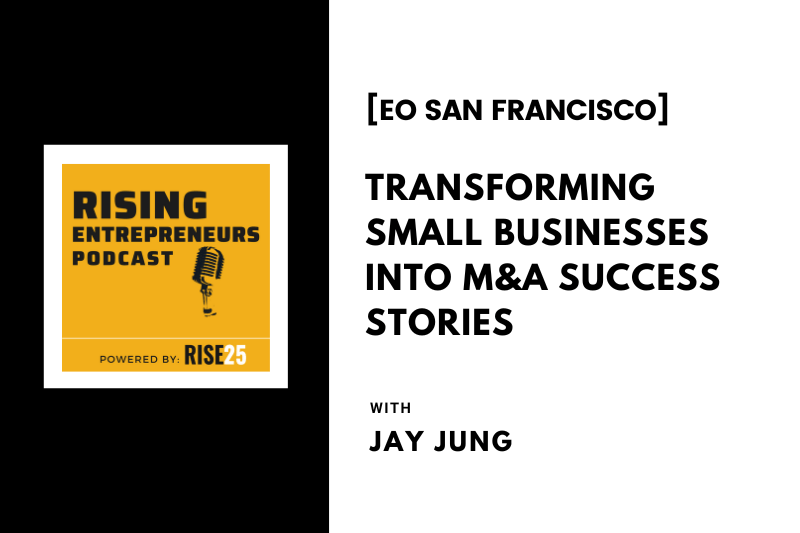John Corcoran 14:32
Got it got it. And tell us about I know there’s one company you worked with it was an IT services company that was you worked with that? Well, they were they were thinking about selling they end up getting a healthy offer a 30 million box or something like that. You negotiated it up but they ended up changing just through that process decided to pursue a different avenue and ended up getting a better result from it. Could you take us through that one?
Jay Jung 14:55
Yeah, this was a one of our earlier IT services clients. I was introduced by About a mutual acquaintance. And when I met them, they already had, like an offer from a couple private equity firms, I looked at the offer I was it was easy to enhance. So they engaged us, we negotiated the offers and made it much better. And then they chose one and kind of pursued that down the path a little bit. But ultimately, they decided to walk away from the deal, even though we almost negotiate everything. And we’re good to go. Mainly because they realized that they weren’t ready to sell. And they found going through the whole process, they realize, wait a minute, like private equity is nothing special, we can actually do our private equity does, which is buy smaller companies at lower multiple, add that to our business, our business grows and gets a higher multiple, and we’re getting that valuation arbitrage anyway. So they turned around and said, You know what, we’re not gonna do the deal. And we’re actually going to do our own private equity playbook. And so we help them do two things. One, we often raise debt. So even though the inside of the whole company, they raise debt, took some money off the table, you know, bought a house and whatnot. And then we help them find opportunities to acquire and then raise more debt to acquire that business. And then, shortly after that, like more private equity buyers got interested, and we ended up running another process to sell the business. And so I’d say All in all, around 18 months later, we sold for almost $50 million. So nificant value out lift. And I really love that case study because it kind of shows what Embarc can do, we’re very agile, and it’s not just about sell, sell, sell, sell, sell. But we can actually say, alright, we’ll change your mind, we’re okay with that. We can help you a different way. And we can help you take some money off the table, we can help you do an acquisition, we can help you sell the whole thing at a huge value uplift. And it doesn’t cost you an arm and a leg.
John Corcoran 16:56
Yeah. I’m curious, you said when you got when that IT services company came to you. And they already had some offers from private equity to sell. And you said that the offer was easy to enhance? I think that was your words. Do you have a process that you go through? When you look at an offer? Obviously, there’s the multiple there’s the total dollar amount, but but what’s your analysis? Like? What do you look at? And what are you looking for when you’re looking at an offer?
Jay Jung 17:26
Yeah, so I think I have the benefit of Pentagon gone through this process multiple times on the sell side. But also we work with private equity firms on the buy side. So we know how they think about it. And normally, on the sell side, when we look at an LOI, there’s probably about 10 to 15 items that we want to look at. It’s not just the headline value. Also, you know, the structure the terms, escrow all that and use some of these otherwise, because it’s usually the first offer just at first glance, there’s already a ton that we think we can go by go back and request and you know, they would provide, they will make concessions. So in that sense, I think having the benefit of looking at so many of these, it was easy to negotiate upwards in value.
John Corcoran 18:16
Yeah. And what’s your approach towards managing the interpersonal elements of these things? Because, you know, I imagine a lot of times you have a client that this is their baby they’ve been building for for many years, most of their net worth is tied up in this company, there can be a lot of anxiety around it, how do you manage those like emotional, emotional and psychological elements of the process?
Jay Jung 18:37
And that’s why reasonably books I see this day you have a massive stack over your shoulder? No. Well, I think an investment banker or m&a advisor inherently has to be a trusted adviser. And I kind of joke that going through m&a, m&a process, especially the sell side, very much entails part of being a part time therapist. And sometimes that’s their therapy between the two co founders. Sometimes it’s just between its with one of the founders that may want to sell one day may not want to sell the other day has anxiety over like, why is the buyer not responding? Or why is the buyer not giving me this? So there’s a lot of emotional factors. And I think we do have to kind of play the role of therapist more often than not, yeah.
John Corcoran 19:28
There’s another case study that we were going to talk about was a recent deal that you had, it was a company that tried to sell twice with a investment bank, it didn’t work out, they got introduced to you and tell it took us through that process.
Jay Jung 19:44
Yeah, so more recent deal where like you said it was actually a sizable company, owned by a husband and wife. They want to sell the business, but it didn’t work out the first go around. I think the first go around was an investment banker it didn’t didn’t work out. And then they said, You know what, we can do it ourselves. And they gave it another goal by themselves didn’t work out. And they had interested buyers, they just couldn’t consummate the transaction for one reason or the other. And so then we got in touch through their legal counsel who we had done some deals together before. And they hired us. And, you know, we ran the process. And again, I can see like, there were a lot of complexities and nuances in the business. And you know, we had the benefit, we have the luxury of being able to spend a lot of time on a specific deal. Since we do we’re not choosing 10 deals at the same time. Long story short, we’re going to probably, we ran a process. And then we got almost like a dozen plus bids. And a handful of them four or five of them were actually significantly higher than what they were expecting.
John Corcoran 20:57
And what do you attribute that to?
Jay Jung 21:00
Well, I think, if you think about it, what’s the same facts tell stories sell. And if you’re out in the market to buy a company, and you get a sim from an investment bank or a broker, chances are it’s 5080 pages, it’s a bunch of slides, and you go through it. It’s, it’s called a confidential information memorandum. So it’s a bunch of facts, there’s no real story. And I think well we as a firm do really well is we take the facts. And then we actually have a shorter deck, you typically our decks are maybe 15 to 25 pages, but it’s all about weaving a story. And I think that really sells well with the buyer because they understand what they’re getting. And I think that allows the people that are really interested invested to stretch a little bit further. And that’s what matters in the margin, who can stretch a little bit further, I don’t need all 12 bits to stretch, I just need three or four bits stretch on the margin. And
John Corcoran 22:04
is that ever hard with your clients, the companies that are looking to sell to convince them of the story? Or did they place their trust in you and say, you know, you tell our story, the way that you think is most compelling to the buyers? Well,
Jay Jung 22:18
it’s an interactive process for for every transaction, we probably spend about six to eight weeks together, I’d say the hard part is getting a lot of the raw data out from them. Because most companies, they don’t have a robust KPI tracking mechanism, a lot of their numbers are not clean. So we have to once we get the data together, and then we hear their story, their qualitative story, I think that where the magic happened is where you can take the story, weave in the numbers together. So it’s a it’s kind of like a a story told in data. And that’s what really resonates with say, a private equity or a strategic work debt buyer, because they’re very, they’re all finance people. Right? So numbers, numbers oriented story is what sells really well. And I think that’s where we make a big difference. And usually when our clients see that, because it’s still their story, where we might sprinkle a little bit of a pixie dust on it. You know, they’ll they’ll, they’ll buy into it. And it’s a collaborative process.
John Corcoran 23:22
Now, I know when these bids came in, they had an interesting reaction. You want to share that?
Jay Jung 23:27
Yeah. So it was it was probably one of the like the our highlights, and this is why I really do this job. So we got over a dozen bids. We went through it with them, and always asks, okay, any any questions? And it was a little pause. And the one question that the business owner asked was, why do they want to pay so much?
John Corcoran 23:49
You must absolutely love that.
Jay Jung 23:51
I’m always prepared with a q&a and try to get ahead of it. But I didn’t have an answer for that one. Because your business is great.
John Corcoran 24:00
Well, and you told the story in a compelling way backed up by data.
Jay Jung 24:05
Yeah, well, so that’s what we do.
John Corcoran 24:07
Yeah. That’s great. That’s great. Well, Jay, this has been great really interesting diving into your story about Embarc and and excited to hear what happens with you in the future. Where can people go to learn more about you and the work that you do?
Jay Jung 24:21
Yeah, so I’m pretty active on LinkedIn. I think my my LinkedIn is Jay Jung, but it’s linkedIn/embarc, and then our website is www.embarcadvisors.com.
John Corcoran 24:36
Excellent. Jay. Thanks so much.
Jay Jung 24:38
Thank you, John.
Outro 24:39
Thanks for listening to the Rising Entrepreneurs Podcast. This episode is powered by Rise25 Please subscribe and check out future episodes.

